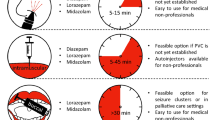Abstract
Traditionally, physiological pharmacokinetic models assume that arterial blood flow to tissue is the rate-limiting step in the transfer of drug into tissue parenchyma. When this assumption is made the tissue can be described as a well-stirred single compartment. This study presents the tissue washout concentration curves of the two opioid analgesics fentanyl and alfentanil after simultaneous 1-min iv infusions in the rat and explores the feasibility of characterizing their tissue pharmacokinetics, modeling each of the 12 tissues separately, by means of either a one-compartment model or a unit disposition function. The tissue and blood concentrations of the two opioids were measured by gas-liquid chromatography. The well-stirred one-compartment tissue model could reasonably predict the concentration-time course of fentanyl in the heart, pancreas, testes, muscle, and fat, and of alfentanil in the brain and heart only. In most other tissues, the initial uptake of the opioids was considerably lower than predicted by this model. The unit disposition functions of the opioids in each tissue could be estimated by nonparametric numerical deconvolution, using the arterial concentration times tissue blood flow as the input and measured tissue concentrations as the response function. The observed zero-time intercepts of the unit disposition functions were below the theoretical value of one, and were invariably lower for alfentanil than for fentanyl. These findings can be explained by the existence of diffusion barriers within the tissues and they also indicate that alfentanil is less efficiently extracted by the tissue parenchyma than the more lipophilic compound fentanyl. The individual unit disposition functions obtained for fentanyl and alfentanil in 12 rat tissues provide a starting point for the development of models of intratissue kinetics of these opioids. These submodels can then be assembled into full physiological models of drug disposition.
Similar content being viewed by others
References
L. E. Mather. Clinical pharmacokinetics of fentanyl and its newer derivatives.Clin. Pharmacokin. 8:422–446 (1983).
J. C. Scott and D. R. Stanski. Decreased fentanyl and alfentanil dose requirements with age. A simultaneous pharmacokinetic and pharmacodynamic evaluation.J. Pharmacol. Exp. Ther. 240:159–166 (1987).
S. Björkman, D. R. Stanski, D. Verotta, and H. Harashima. Comparative tissue concentration profiles of fentanyl and alfentanil in humans predicted from tissue/blood partition data obtained in rats.Anesthesiology 72:865–873 (1990).
D. Verotta, L. B. Sheiner, W. F. Ebling, and D. R. Stanski. A semiparametric approach to physiological flow models.J. Pharmacokin. Biopharm. 17: 463–491 (1989).
K. B. Bischoff. Some fundamental considerations of the applications of pharmacokinetics to cancer chemotherapy.Cancer Chemother. Rep. 59:777–793 (1975).
L. E. Gerlowski and R. K. Jain. Physiologically based pharmacokinetic modeling: Principles and applications.J. Pharm. Sci. 72:1103–1127 (1983).
K. J. Himmelstein and R. J. Lutz. A review of the applications of physiologically based pharmacokinetic modeling.J. Pharmacokin. Biopharm. 7:127–145 (1979).
M. Rowland. Physiologic pharmacokinetic models: Relevance, experience and future trends.Drug Metab. Rev. 15:55–74 (1984).
S. Björkman and D. R. Stanski. Simultaneous determination of fentanyl and alfentanil in rat tissues by capillary column gas chromatography.J. Chromatogr. 433:95–104 (1988).
C. Long.Biochemists Handbook, Van Nostram, Princeton, NJ, 1968, p. 639.
N. Pace and D. F. Rahlmann. Estimation of skeletal muscle mass from body creatine content.Physiologist 25:S83-S84 (1982).
H. B. Waynforth.Experimental and Surgical Techniques in the Rat, Academic Press, London, 1980, p. 240.
S. F. Flaim, S. H. Nellis, E. J. Toggart, H. Drexler, K. Kanda, and E. D. Newman. Multiple simultaneous determinations of hemodynamics and flow distribution in the conscious rat.J. Pharmacol. Meth. 11:1–39 (1984).
M. Gibaldi and D. Perrier.Pharmacokinetics, 2nd ed., Marcel Dekker, New York, 1982, pp. 45–109.
W. F. Ebling, E. N. Lee, and D. R. Stanski. Understanding pharmacokinetics and pharmacodynamics through computer simulation: I. The comparative clinical profiles of fentanyl and alfentanil.Anesthesiology 72:650–658 (1990).
D. Verotta. An inequality-constrained least-squares deconvolution method.J. Pharmacokin. Biopharm. 17:269–289 (1989).
N. A. Lassen and W. Perl.Tracer Kinetic Methods in Medical Physiology, Raven Press, New York, 1979, pp. 76–99.
J. W. Mandema, P. Veng-Pedersen, and M. Danhof. Estimation of amobarbital plasma-effect site equilibration kinetics. Relevance of poly-exponential conductance functions.J. Pharmacokin. Biopharm. 19:617–634 (1991).
N. B. Everett, B. Simmons, and E. P. Lasher. Distribution of blood (Fe59) and plasma (I131) volumes of rats determined by liquid nitrogen freezing.Circulation Res. 4:419–424 (1956).
M. Yaster, R. C. Koehler, and R. J. Traystman. Effects of fentanyl on peripheral and cerebral hemodynamics in neonatal lambs.Anesthesiology 66:524–530 (1987).
N. D. Kien, J. A. Reitan, D. A. White, C.-H. Wu, and J. H. Eisele. Hemodynamic responses to alfentanil in halothane-anesthetized dogs.Anest. Analg. 65:765–770 (1986).
W. E. G. Meuldermans, R. M. A. Hurkmans, and J. J. P. Heykants. Plasma protein binding and distribution of fentanyl, sufentanil, alfentanil and lofentanil in blood.Arch. Int. Pharmacodyn. Ther. 257:4–19 (1982).
J. L. Gabrielsson, P. Johansson, U. Bondesson, and L. K. Paalzow. Analysis of methadone disposition in the pregnant rat by means of a physiological flow model.J. Pharmacokin. Biopharm. 13:355–372 (1985).
J. L. Gabrielsson and T. Groth. An extended physiological pharmacokinetic model of methadone disposition in the rat: Validation and sensitivity analysis.J. Pharmacokin. Biopharm. 16:183–201 (1988).
J. L. Gabrielsson, P. Johansson, U. Bondesson, M. Karlsson, and L. K. Paalzow. Analysis of pethidine disposition in the pregnant rat by means of a physiological flow model.J. Parmacokin. Biopharm. 14:381–395 (1986).
T. K. Henthorn, T. C. Krejcie, and M. J. Avram. The relationship between alfentanil distribution kinetics and cardiac output.Clin. Pharmacol. Ther. 52:190–196 (1992).
Author information
Authors and Affiliations
Additional information
Supported in part by the National Institute on Aging, RO1-AG-4594, the Anesthesia/ Pharmacology Research Foundation, and a travel grant from Janssen Pharma AB (Sweden).
Rights and permissions
About this article
Cite this article
Björkman, S., Stanski, D.R., Harashima, H. et al. Tissue distribution of fentanyl and alfentanil in the rat cannot be described by a blood flow limited model. Journal of Pharmacokinetics and Biopharmaceutics 21, 255–279 (1993). https://doi.org/10.1007/BF01059779
Received:
Revised:
Published:
Issue Date:
DOI: https://doi.org/10.1007/BF01059779




